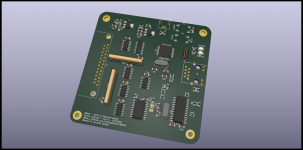saybur
Well-known member
Great graphic, that's how I'd do it. Since the 245 is permanently reading from the bus you should be able to tie DIR without a problem. In case the bus floats for some reason (bad termination?) you might want to toggle /OE only when you know data is on the bus. The LVT transceivers have a 10ns/V transition time recommendation with "outputs enabled," so the current scuznet firmware does toggle /OE to avoid having the outputs on except when necessary, in case the SCSI bus is being sluggish during transitions. I don't know if this is strictly "needed" or not.
For bus reading, the buffer is there mainly for 5V protection (the Xmegas are TTL compatible at 3.3V). You could probably get away with not using the buffer, depending on what's on the bus: if all devices are open-collector, you should only see 2.63-3.0V on the lines. However, SCSI does allow push-pull drivers on most lines, and those can output up to 5.5V and still be in spec. I'm not familiar with the STM32s, so they may have 5V tolerant GPIO pins to avoid the problem.
For bus reading, the buffer is there mainly for 5V protection (the Xmegas are TTL compatible at 3.3V). You could probably get away with not using the buffer, depending on what's on the bus: if all devices are open-collector, you should only see 2.63-3.0V on the lines. However, SCSI does allow push-pull drivers on most lines, and those can output up to 5.5V and still be in spec. I'm not familiar with the STM32s, so they may have 5V tolerant GPIO pins to avoid the problem.

